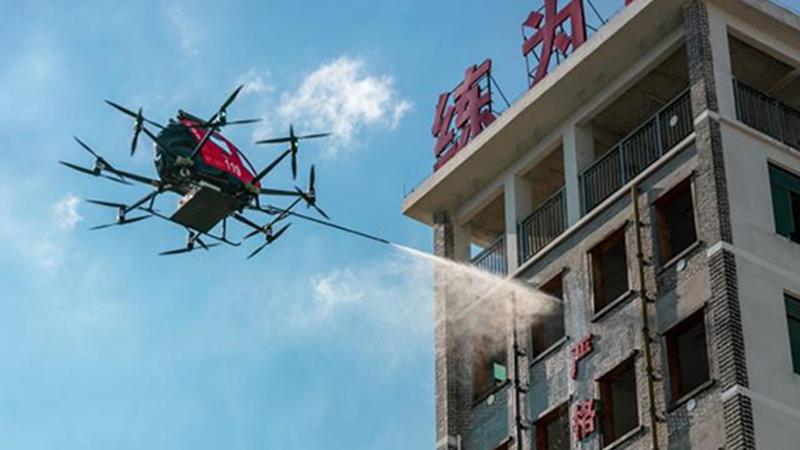

Image Credit: Ehang
The industry reach of eVTOLs is seemingly limitless, and emergency response is no exception. We previously wrote about the use of eVTOLs in medical response, but what about other time-critical scenarios?
Next in the firing line is firefighting. How will eVTOLs aid in our defence against fires, and what impact could this have on the future?
Firefighting has received less attention than medical response, but there is already a concept in development. EHang, the Chinese developer that partnered with Lung Biotechnology for organ transport, is also investigating the firefighting sector.
Last year, the company announced that it had adapted its 216 AAV to fight fires. The autonomous drone features all the hallmarks of an eVTOL: multicopter design, fast-charging battery, intelligent operating system, and numerous fail-safes.
Although developed as an air taxi, EHang easily adapted it to its new role. The 216F can carry up to 150 litres of foam and six extinguisher bombs. It identifies fires using a camera and laser aiming system, meaning it can break windows and deliver precision shots of foam.
It will help with high-rise building fires, as it can reach the site more quickly than traditional firefighting systems. Considering it is a time-critical operation, this could make a massive difference.
Due to its battery life and carrying capacity, EHang states it will assist on missions with a five-kilometre radius of its base. But, if positioned at every fire station in a city, it would be more than enough to cover most emergencies.
While EHang is the only eVTOL developer to announce a firefighting concept, it is unlikely to be the last. The additional hardware would not be impossible to incorporate into many other designs, particularly on eVTOLs designed for logistical and cargo industries.
The greatest benefit of using eVTOLs in firefighting is the same as other emergency response fields. They can respond to time-critical situations more easily than manned units. If the aircraft is charged and filled, all it needs to do is take off and reach the emergency.
Also, as illustrated in EHang’s plans, eVTOLs will revolutionise high-rise fire response. They will be particularly beneficial in unsafe buildings and will save firefighters from entering dangerous environments. Although firefighter fatalities are not as high as expected, any reduction in danger is a benefit.
An indirect benefit of using eVTOLs in emergency response is the impact on public perception. If sceptics see an autonomous aircraft working efficiently in these situations, it might improve progress in fields such as public transport.
As we have discussed before, official certification is only half the battle. Convincing people to get into an unmanned aircraft is another thing entirely, and seeing them excel in emergency fields might help with this.
The biggest challenge relates to dealing with evacuation and medical response in emergency situations. How will an autonomous aircraft deal with an unconscious person suffering from smoke inhalation? Will firefighters still have to ride the aircraft so they can rescue people from the burning building? These are vital questions that do not yet have answers, but will be a major sticking point in the full rollout of firefighting eVTOLs.
As more industries become automated, it begs the question: can we automate emergency response? eVTOL developers would argue yes, but the extent to which this is true is currently unclear. Human decision-making and intervention will be key, at least until we develop AI capable of mimicking it.
For now, though, testing and use-cases of firefighting eVTOLs will likely remain a relatively niche field.
